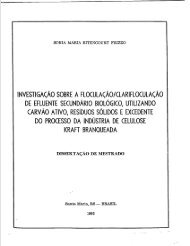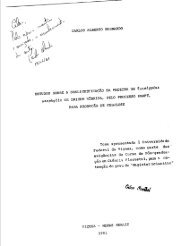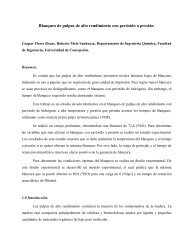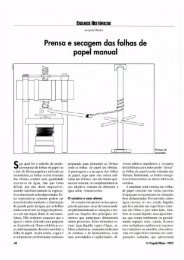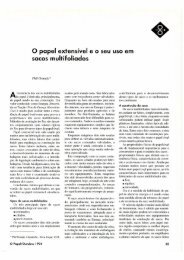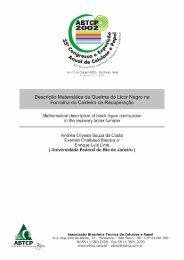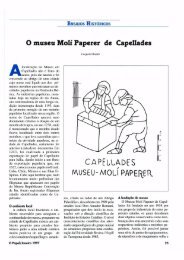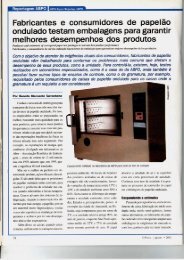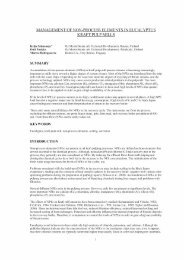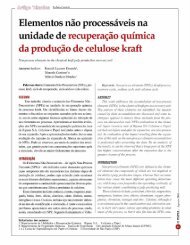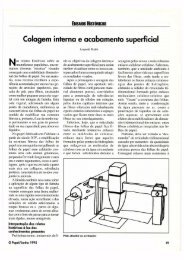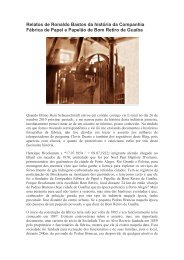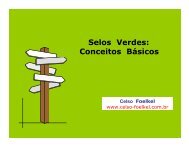O Eucalipto: um século no Brasil (The Eucalypt - Celso Foelkel
O Eucalipto: um século no Brasil (The Eucalypt - Celso Foelkel
O Eucalipto: um século no Brasil (The Eucalypt - Celso Foelkel
Create successful ePaper yourself
Turn your PDF publications into a flip-book with our unique Google optimized e-Paper software.
1 9 6 B I L H Õ E S T O N E L A D A S D E C A R B O N O N O S E U C A L I P T A I S - 1 9 6 B I L L I O N T O N S O F C A R B O N I N T H E E U C A L Y P T S P L A N T A T I O N S<br />
125<br />
Protocolo de Kyoto<br />
Kyoto Protocol<br />
Preocupados com o aquecimento global, 162 países assinaram em 1997 o Protocolo de<br />
Kyoto, com o compromisso de reduzir a emissão de gases causadores do efeito estufa em<br />
5% aquém dos níveis de 1990. Foi previsto também que se <strong>um</strong>a indústria não conseguia ou<br />
não queria reduzir sua emissão, podia comprar créditos de carbo<strong>no</strong>, isto é, pagar para que<br />
mesmo em outros países, alguém seqüestrasse carbo<strong>no</strong> em seu <strong>no</strong>me e com dinheiro dela.<br />
Um de seus desdobramentos é a ‘Chicago Climate Exchange’, <strong>um</strong>a bolsa de negócios que,<br />
desde fevereiro de 2005, comercializa créditos oferecidos pelas empresas que plantam<br />
árvores, inclusive as brasileiras. As quatro primeiras empresas florestais brasileiras que<br />
comercializaram projetos através desse mecanismo alternativo foram a ‘Klabin’, que ofereceu<br />
dois milhões de toneladas de CO2, a ‘Votorantim Celulose e Papel’, 850 milhões de<br />
toneladas, a ‘Suza<strong>no</strong>’, 5 milhões de toneladas e a ‘Aracruz Celulose’, entre outras.<br />
O seqüestro do carbo<strong>no</strong> não é permanente, porém. Com o tempo o carbo<strong>no</strong> volta a ser<br />
liberado na atmosfera e o exemplo mais gritante é o da cana. Ao crescer durante <strong>um</strong> a<strong>no</strong>,<br />
o canavial seqüestra carbo<strong>no</strong>, mas quando as folhas e o bagaço são queimados, o carbo<strong>no</strong><br />
é liberado e o restante volta para a atmosfera quando o álcool combustível queima n<strong>um</strong><br />
motor. Mal comparando, trata-se de <strong>um</strong> “seqüestro-relâmpago”.<br />
Concerned with global heating, 162 nations signed the Kyoto Protocol in 1997, committing<br />
to slash the emission of greenhouse effect-causing gases by 5% below the 1990’s<br />
levels. It was also forecast that if one industry were unable or unwilling to reduce its<br />
emission, it could purchase the so-called carbon credits, i.e., pay someone, even if in a<br />
different country, to sequester carbon on its behalf and with its money.<br />
One of its unfolding is the Chicago Climate Exchange, a business exchange which, since<br />
February 2005, markets credits offered by companies that plant trees, including Brazilian<br />
ones. <strong>The</strong> first four Brazilian forest companies to market projects through this alternative<br />
mechanism were ‘Klabin,’ which offered 2 million tons of CO2, ‘Votorantim Celulose e<br />
Papel,’ 850 million tons, ‘Suza<strong>no</strong>,’ 5 million tons, and ‘Aracruz Celulose,’ among others.<br />
Carbon sequestration is <strong>no</strong>t permanent, however. In time, carbon is released back into<br />
the atmosphere, and the clearest example of this is sugarcane. While it grows for a year,<br />
the sugarcane plantation sequesters carbon, but when the leaves and the bagasse are<br />
burnt, the carbon is released and the remaining portion goes back in to the atmosphere<br />
when the etha<strong>no</strong>l is burnt in an engine. Poorly compared, it is an “instant hijack,” so<br />
to speak.




